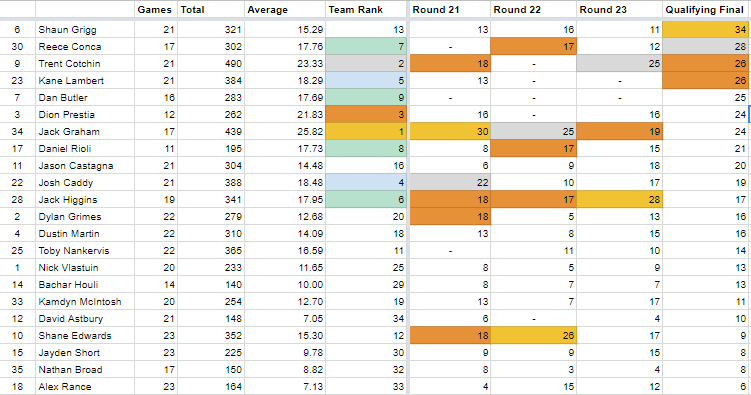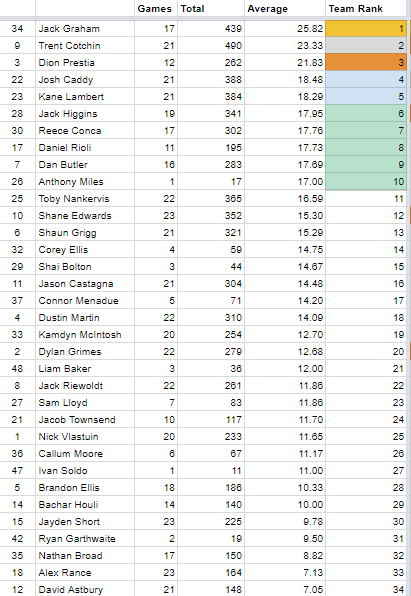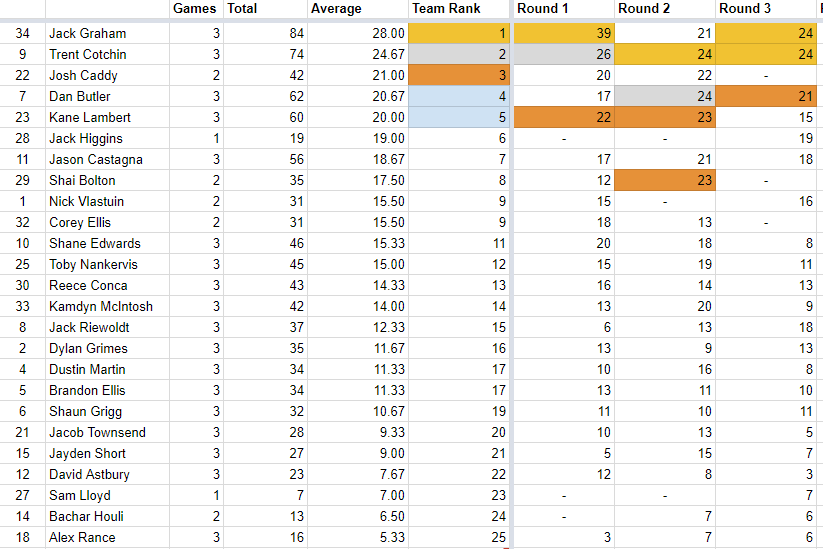Would love to know where to find such a stat. it's odd it's a huge part of the game now but these #'s are nowhere to be found.Pretty sure someone said 1.63, well below our average.
Navigation
Install the app
How to install the app on iOS
Follow along with the video below to see how to install our site as a web app on your home screen.
Note: This feature may not be available in some browsers.
More options
You are using an out of date browser. It may not display this or other websites correctly.
You should upgrade or use an alternative browser.
You should upgrade or use an alternative browser.
Analysis Pressure Acts Spreadsheet
- Thread starter NimFromSudan
- Start date
-
- Tags
- pressure acts statistics stats
- Tagged users None
Ditto, been told Champion data sell this to the media and clubs and they release it occasionally in articles/press releases.Would love to know where to find such a stat. it's odd it's a huge part of the game now but these #'s are nowhere to be found.
SHame it's not ready available, but I guess they do need to make some $$'s
These stats do tend to show why Higgins is playing so much footy this year. Playing his role.
I've never noticed, will have to pay more attentionThe only way I know how to see it is after games on fox footy, theres stats rolling across the bottom of the screen and it says it
Tenacious T
Premiership Member🏆
- Jun 6, 2018
- 2,550
- 15,387
- AFL Club
- Richmond
- Other Teams
- MUFC, MVFC
Love to see how other clubs PA stats for comparison.
NimFromSudan
Club Legend
- Thread starter
- #207
Qualifying Final

2018

Absolutely massive game. Second best team total only behind round 20 against Geelong.
Season bests for Lambert, Riewoldt and Grigg.

2018

Absolutely massive game. Second best team total only behind round 20 against Geelong.
Season bests for Lambert, Riewoldt and Grigg.
Qualifying Final

2018

Absolutely massive game. Second best team total only behind round 20 against Geelong.
Season bests for Lambert, Riewoldt and Grigg.
Love your work Nim, it’s been fantastic.
Although I question Dan Butler’s numbers from the QF considering he didn’t play
NimFromSudan
Club Legend
- Thread starter
- #209
I've since corrected that on my own spreadsheet but that's actually Jack's 25. Uploaded the wrong screencaps.Love your work Nim, it’s been fantastic.
Although I question Dan Butler’s numbers from the QF considering he didn’t play
Love your work Nim, it’s been fantastic.
Although I question Dan Butler’s numbers from the QF considering he didn’t play
Dan may have gotten those pressure acts on a wench sitting next to him in the stands.
Pressure acts are a pretty important stat to the way Richmond play but the only place I can find them is deep in the AFL app. I've built this spreadsheet so that we can compare players and track them across the season.
Here's a screen-cap of this weeks leader-board.

Cotch and Graham are standouts while Caddy, Butler and Lambert chase behind. You can see players that make their way forward have the best numbers, as do the inside mids. Martin is the exception as this looks like a weak area for him.
Interesting for me was to see Townsend's numbers so low. Makes me think he has less leeway than we all assume when he's not kicking goals
are our "pressure measures" the same as AFLs and Champion Data? assume we well-developed our own discrete metrics. It may be as simple as getting to position and standing in the correct area... bare with me...
my example to explicate this point is Tom Scully of GWS.
He can cover enormous swathes of the ground by using his unpeered running ability. This effectively makes the ground larger and smaller. Smaller for GWS by presenting the 18.5th man (18 1/2 men). His running makes his unit value 1.5 men. He creates more contests on a wing from the same-amount of players. He offers more options by pulling defenders north and south and laterally. I think in the NBA, with perimeter shooting 12 feet beyond the threepointline, they call this g.r.a.v.i.t.y. by drawing a 5 man-defense further to the outskirts of their defensive set, which makes the key more vulnerable. IE. larger for the opposition, more territory to cover with the same 18 men.
Zgope1
Tom Scully can do this on the wing by presenting over and over and over again. Like Nick Riewoldt did to CHB's for a decade by hitting up and presenting repeat times.
My point, we may have a metric when players are measured to be in defensive position, or not in defensive position. These will be our team's exclusive metrics towards how our game plan is set up. Not Champion Data generic measurment(s). Because sometimes our coaching instruction will be not to gamble upon making a tackle'able tackle. Simply the best act is to corral the player and force the opponent to make a decision likely to benefit our set-up more than a tabula rasa good disposal or the chaos ball where they may (or may not) have numbers and can benefit. In this case, NOT making a tackle is in our interests. But performing a tackle will add to the pressure statistics (upside down stats). So I assume we grade the individual acts different.
Also, if we look at the stats. Like the brownlow, this weighs disproportionately on those players in the guts. Who are obviously exposed to many more contests.
We dont see the
Dusty knows where his energies are best expended. trying to win (and succeeding!) on winning the game on the offensive* end.
NimFromSudan so the pressure spreadsheet for Dusty's numbers does not tell the story. If his numbers went up, yet constrained his ability to use his offensive weapons, this would only be seen as a positive for those reverse-engineering and Brendan Goddard's tackle-count numbers. It is JohnNashPrincetonAdvancedInstitute GameTheory nobel prize winning paper in behavioural economics. Remember when the media doorstopped Brendan Goddard two months back to question him on his tackle stats? We have no appreciation of Worsfold's role he gave BJ. Reverse engineering cray'cray-craziness of idjits in meeedja thinking stats dictated game scores <eyesroll>
Last edited:
I think where you’re going becomes subjective, best done by actual analysis rather than statsare our "pressure measures" the same as AFLs and Champion Data? assume we well-developed our own discrete metrics. It may be as simple as getting to position and standing in the correct area... bare with me.
my example to explicate this point is Tom Scully of GWS.
He can cover enormous swathes of the ground by using his unpeered running ability. This effectively makes the ground larger and smaller. Smaller for GWS by presenting the 18.5th man (18 1/2 men). His running makes his unit value 1.5 men. He creates more contests on a wing from the same-amount of players. He offers more options by pulling defenders north and south and laterally. I think in the NBA, with perimeter shooting 12 feet beyond the three, they call this g.r.a.v.i.t.y. by drawing a 5 man-defense further to the outskirts of their defensive set, which makes the key more vulnerable. IE. larger for the opposition, more territory to cover with the same 18 men.
Zgope1
Tom Scully can do this on the wing by presenting over and over and over again. Like Nick Riewoldt did to CHB's for a decade by hitting up and presenting repeat times.
My point, we may have a metric when players are measured to be in defensive position, or not. These will be our team's exclusive metrics towards how our game plan is set up. Not Champion Data generic measurment(s). Because sometimes our coaching instruction will be not to gamble upon making a tackle'able tackle. Simply the best act is to corral the player and force the opponent to make a decision likely to benefit our set-up more than a tabula rasa good disposal or the chaos ball where they may (or may not) have numbers and can benefit. In this case, NOT making a tackle is in our interests. But performing a tackle will add to the pressure statistics (upside down stats). So I assume we grade the individual acts different.
Also, if we look at the stats. Like the brownlow, this weighs disproportionately on those players in the guts. Who are obviously exposed to many more contests.
We dont see thespreadshits[sic]spreadsheet for 'pressure act failed to perform'. NB. Dusty failing to perform a pressure act would, one assumes, be a concsious decision not to expend his energy and ration his energy for the final quarter. Cotch could still get 30 possessions, 30 possessions I am not counting the cheapie handpass behind the back of a set-kick. Cotch could still do 30 possies, but his pressure would suffer.
Dusty knows where his energies are best expended. trying to win (and succeeding!) on winning the game on the offensive* end.
NimFromSudan so the pressure spreadsheet for Dusty's numbers does not tell the story. If his numbers went up, yet constrained his ability to use his offensive weapons, this would only be seen as a positive for those reverse-engineering and Brendan Godard's tackle-count numbers. It is JohnNashPrincetoneAdvancedInstitute GameTheory nobel prize winning paper in behavioural economics. Remember when the media doorstopped Brendan Godard two months back to question him on his tackle stats? We have no appreciation of Worsfold's role he gave BJ. Reverse engineering cray cray craziness of idiots in meeedja thinking stats dictated game scores <eyesroll>
right. but folks wanna distil it into concrete stats, and doorstop Brendan Goddard and tell him he got no tackles. And Dusty's pressure numbers are lacking... well it is opportunity cost, by performing the defensive acts will detract from his brownlow form. Defensive/pressure acts, more pressure acts conspire to hurt his game. And be extraction, our game. Tigers game.I think where you’re going becomes subjective, best done by actual analysis rather than stats
- Apr 27, 2014
- 29,428
- 57,933
- AFL Club
- Richmond
- Other Teams
- The Fanboi Farters
That’s your most intelligent inquiring and informativeare our "pressure measures" the same as AFLs and Champion Data? assume we well-developed our own discrete metrics. It may be as simple as getting to position and standing in the correct area... bare with me.
my example to explicate this point is Tom Scully of GWS.
He can cover enormous swathes of the ground by using his unpeered running ability. This effectively makes the ground larger and smaller. Smaller for GWS by presenting the 18.5th man (18 1/2 men). His running makes his unit value 1.5 men. He creates more contests on a wing from the same-amount of players. He offers more options by pulling defenders north and south and laterally. I think in the NBA, with perimeter shooting 12 feet beyond the three, they call this g.r.a.v.i.t.y. by drawing a 5 man-defense further to the outskirts of their defensive set, which makes the key more vulnerable. IE. larger for the opposition, more territory to cover with the same 18 men.
Zgope1
Tom Scully can do this on the wing by presenting over and over and over again. Like Nick Riewoldt did to CHB's for a decade by hitting up and presenting repeat times.
My point, we may have a metric when players are measured to be in defensive position, or not. These will be our team's exclusive metrics towards how our game plan is set up. Not Champion Data generic measurment(s). Because sometimes our coaching instruction will be not to gamble upon making a tackle'able tackle. Simply the best act is to corral the player and force the opponent to make a decision likely to benefit our set-up more than a tabula rasa good disposal or the chaos ball where they may (or may not) have numbers and can benefit. In this case, NOT making a tackle is in our interests. But performing a tackle will add to the pressure statistics (upside down stats). So I assume we grade the individual acts different.
Also, if we look at the stats. Like the brownlow, this weighs disproportionately on those players in the guts. Who are obviously exposed to many more contests.
We dont see thespreadshits[sic]spreadsheet for 'pressure act failed to perform'. NB. Dusty failing to perform a pressure act would, one assumes, be a concsious decision not to expend his energy and ration his energy for the final quarter. Cotch could still get 30 possessions, 30 possessions I am not counting the cheapie handpass behind the back of a set-kick. Cotch could still do 30 possies, but his pressure would suffer.
Dusty knows where his energies are best expended. trying to win (and succeeding!) on winning the game on the offensive* end.
NimFromSudan so the pressure spreadsheet for Dusty's numbers does not tell the story. If his numbers went up, yet constrained his ability to use his offensive weapons, this would only be seen as a positive for those reverse-engineering and Brendan Godard's tackle-count numbers. It is JohnNashPrincetoneAdvancedInstitute GameTheory nobel prize winning paper in behavioural economics. Remember when the media doorstopped Brendan Godard two months back to question him on his tackle stats? We have no appreciation of Worsfold's role he gave BJ. Reverse engineering cray cray craziness of idiots in meeedja thinking stats dictated game scores <eyesroll>
Post and you’ve posted lots of good ones. I’m with you on the Dusty analysis as you can’t have everybody constantly pressuring as you need that break line player to create havoc once the pressure experts have won the ball in our favour. Dusty is the contested Beast and go to man so he can put the polish on the hard work of others.
Cotchin imo preserves himself as he can do both as this is what his role demands. He’s like that efficient bloke who lives in the industrial workshop and can set up all the machines running whilst applying perceived pressure and then sneaks off into the lunch room to have a coffee and sandwich while catching up with the days news with his nose firmly entrenched in a newspaper. He then wanders back and puts the final polish on his work .
I remember reading Joel Selwood interview a few years back where he spoke of measuring(rationing) his efforts early in the game and to save his legs for the final quarter(s).That’s your most intelligent inquiring and informative
Post and you’ve posted lots of good ones. I’m with you on the Dusty analysis as you can’t have everybody constantly pressuring as you need that break line player to create havoc once the pressure experts have won the ball in our favour. Dusty is the contested Beast and go to man so he can put the polish on the hard work of others.
Cotchin imo preserves himself as he can do both as this is what his role demands. He’s like that efficient bloke who lives in the industrial workshop and can set up all the machines running whilst applying perceived pressure and then sneaks off into the lunch room to have a coffee and sandwich while catching up with the days news with his nose firmly entrenched in a newspaper. He then wanders back and puts the final polish on his work .
metaphor- aka Kevin McHale perennial 6th-Man-of-the-Year... Red Aubach would insert him besides Bird and Parish with any role or spot needing fixing. with Hakeem best ever low post player with the back to the basket.
Last edited:
NimFromSudan
Club Legend
- Thread starter
- #216
NimFromSudan
Club Legend
- Thread starter
- #217
Thx very much for posting these #'s throughout the season, very much appreciated & hope for more next year.2017-2018 Comparisons
View attachment 562176
Note of course that players like Soldo, Bolton, Miles who had small sample sizes shouldn't really be looked at.
- Apr 27, 2014
- 29,428
- 57,933
- AFL Club
- Richmond
- Other Teams
- The Fanboi Farters
As above . Thanks for all of those stats you’ve provided us with and the hard work you put into collating them.2017-2018 Comparisons
View attachment 562176
Note of course that players like Soldo, Bolton, Miles who had small sample sizes shouldn't really be looked at.
RunningBounce
Premiership Player
- Jun 12, 2013
- 4,484
- 10,142
- AFL Club
- Richmond
Thanks NimFromSudan. Appreciate your work all season.
NimFromSudan
Club Legend
- Thread starter
- #222
Not a worry at all, everyone. Fingers crossed I'll be able to do it again next year.
- Banned
- #223
I want to take this opportunity to defend Conca, using this thread as my own little soapbox for a second. He's not going to be dropped, he shouldn't be dropped. We should be singing his praises. He's not only gotten healthy and played 12 straight games, he's done it while moving positions and becoming a genuine inside mid for the first time in more than 5 years for him. It's astounding to me that he gets called to be dropped after 9 tackles and 20+ disposals. I'll admit his stats have him playing a slightly better game than my eye saw but even the most inattentive viewer can tell that's a great game, not a sh*t one. He's clearly a defensive star, leads the club in total tackles and is now 4th in average pressure acts. I know his disposal isn't particularly slick, but it's definitely made out to be worse than it is because he has more out-and-out shocking turnovers.
Take a look at Richmond midfielders compared for efficiency and clearance stats on StatsPro here:
Key: Disposals, Disposal Efficiency, Kicking Efficiency, Kick:Handball ratio, Contested Possessions, Turnovers, Centre clearances, Clearances, tackles.

His total turnovers (sorted column - fourth from right) is poor, but on par with Cotch, Dusty and Grigg (admittedly wins a few less disposals a game). His Kicking Efficency (KE - third column) is better than Cotch, Dusty, Caddy and Prestia.
He's not a star we all know that, but only Cotchin and Lambert provide the same contribution on both sides of the ball.
The stats pro app / Website is pretty good now
Similar threads
- Replies
- 38
- Views
- 1K
- Replies
- 152
- Views
- 5K
- Replies
- 95
- Views
- 3K
- Poll
- Replies
- 37
- Views
- 902
- Replies
- 8
- Views
- 652









